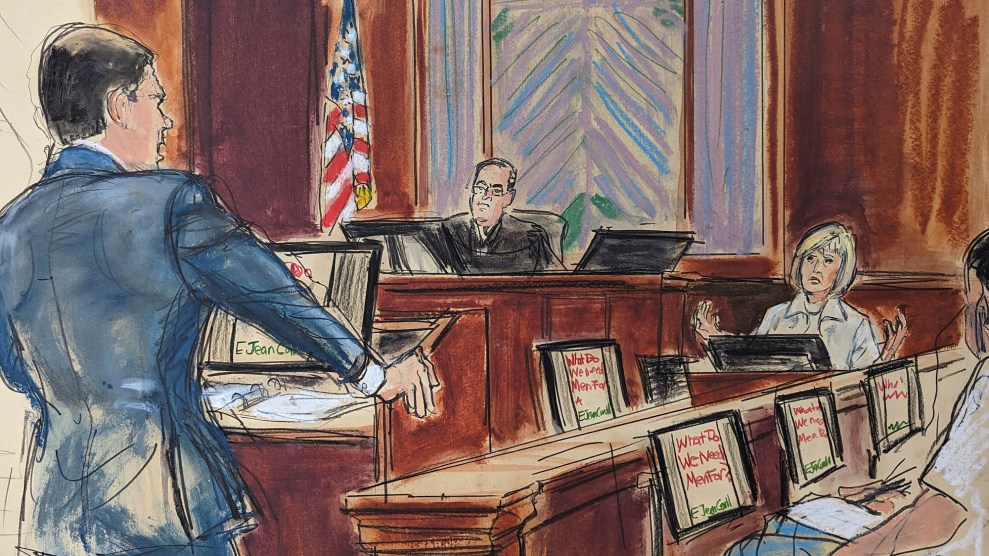
Stephanie Keith/Getty; Robert Perry/Getty
Attorneys for both sides in Donald Trump’s sexual assault and defamation civil lawsuit made their final pleas to the jury Monday, with rival attorneys for Trump and E. Jean Carroll, the writer who says Trump raped her in a department store dressing room in 1996, talking for hours, trying to sum up their cases.
Carroll’s attorneys said Trump wanted jurors to believe that not only was she lying, so were two friends who testified that Carroll told them of the alleged attack at the time it happened, two other women who testified about similar experiences with Trump, and multiple witnesses who testified that Carroll’s recollection of the Bergdorf Goodman department store, where Carroll says the attack took place, was accurate. “This is not a he said, she said,” Roberta Kaplan, one of Carroll’s attorneys, told jurors. “It’s what Donald Trump says vs. what all 11 of these witnesses said in that chair over there.”
“In order for you to find for him, you need to conclude that Donald Trump, the nonstop liar, is the only person in this courtroom who has been telling the truth,” she added.
Kaplan said that Trump actually wanted jurors to believe that all these people had concocted a giant conspiracy—a “big lie” to get Trump—for political reasons. “I’m sorry, seriously?” she said scoffing. “That’s just ridiculous. There’s no evidence, not a shred, that a conspiracy exists.”
But that is exactly what Trump’s lawyer, Joe Tacopina, claimed during his nearly two-and-a-half-hour closing argument. He meandered at times, eventually building up to a shouting crescendo, calling Carroll a liar, and insisting there was indeed a conspiracy against his client. Tacopina’s strategy seemed to involve sowing doubt in every way possible, as he offered a variety of ways the conspiracy might have developed and blamed various people, primarily Carroll. He claimed that Trump’s accuser and her two friends, Lisa Bernbach and Carol Martin—the ones who testified she’d told them about the incident shortly after—cooked up a story because they hated Trump for his politics.
Until she began working on her 2019 book, Carroll contends, Bernbach and Martin were the only people she had told in the decades since the assault. “She told two very, very close friends to go along with a story that started off as a book,” Tacopina told jurors. “They hated him with a passion and never thought it would go further.”
Tacopina said that after Carroll encountered Republican operative George Conway, a prominent anti-Trump Republican who Tacopina repeatedly mislabled a “Democratic attorney,” Conway “got his hooks into her” and convinced her to sue. The lawyer focused on a text Martin had sent to another friend in 2021, discussing Carroll’s involvement with an initially unsuccessful New York bill that would have given sexual assault victims a one-year window to sue their attackers, no matter how old the incident. The bill did pass the following year, allowing Carroll to sue Trump. In the text, Martin had complained that Carroll was celebrating something that “hasn’t really happened.”
Tacopina said the message referred to Carroll’s assault story. But her attorneys countered that it referred to the bill’s passage, which had not yet occurred.
Carroll’s attorneys spent most of their closing argument focusing on a theme similar to one from their opening—that Trump has a modus operandi with women. He used it in his alleged attack on Carroll, they said, and on multiple others who testified about alleged assaults; Trump described it himself in the infamous Access Hollywood tape.
Carroll previously testified that she ran into Trump at Bergdorf Goodman, across from Trump Tower, in early spring 1996. Carroll said that after he asked her to help him find a gift for a woman, they wandered the store flirting, and then he led her into a dressing room where he abruptly lunged at her, slamming her against the wall, forcefully kissing her and grabbing her genitals before raping her.
Two witnesses related their own, similar stories for the jury: One is journalist Natasha Stoynoff, who testified that Trump had grabbed her and pushed her against the wall and kissed her at Mar-a-Lago. The other is Jessica Leeds, who alleges Trump grabbed her, groped her, and forcefully kissed her when they were seated next to each other on an airplane. Carroll’s attorneys also repeatedly played the Access Hollywood tape, in which Trump was caught on a hot mic bragging about how he took one woman shopping and tried to seduce her—and suggesting that he sometimes approaches women he desires by kissing them and grabbing their genitals.
Tacopina tried to downplay the tape, calling it an example of “locker room talk,” but Carroll attorney Mike Ferrara begged to differ: “I have another word for it. It was a confession,” he said. “Locker room talk can be crude. That’s not what that was. That video is a confession.”
Tacopina also defended himself to jurors about a testy exchange he had with Carroll when she was on the stand, in which he pressed her about why she didn’t scream during the alleged assault. Carroll said she didn’t need an excuse. As I wrote previously, Carroll turned the tables on Tacopina that day:
“Women who don’t come forward—one of the reasons they don’t come forward is because they all get asked, ‘Why didn’t you scream?’” Carroll said, her voice rising. “Some women scream, some women don’t. It keeps them silent.”
“You’d better have a good excuse as to why you didn’t scream; if you don’t scream, you weren’t raped,” Carroll continued, mocking his line of questioning. “I’m telling you, he raped me, whether I screamed or not!”
On Monday, Tacopina insisted he wasn’t wrong to question Carroll on why she didn’t scream or call the police.
“I’m a father of two daughters. I would never tell a real rape victim on how they should act,” Tacopina said.
Ferrara shot back in a rebuttal after Tacopina spoke: “It feels like the defense has this idea of the perfect rape victim,” he said. “The perfect rape victim never flirts. The perfect rape victim always screams. The prefect rape victim never goes back to where they were raped. The perfect rape victim tells the police but never speaks about it in public. In their version, a perfect rape victim burns whatever clothes they were wearing, and never laughs again, never tries to hold their rapist accountable. It’s the defense’s out of date view—as wrong as it is offensive.”
The jury will receive its final jury instructions Tuesday morning and begin deliberations. They will be asked to consider both whether Trump assaulted Carroll and whether he defamed her when he called her a liar and said she was “not my type” after she went public.
On the first question—the assault—jurors will decide based on a preponderance of evidence, a much lower standard than the one used in criminal cases. It only requires jurors to conclude that Trump more likely than not assaulted Carroll. If they do find Trump liable, they will then decide whether Trump defamed her, with a slightly higher standard of evidence, and decide how much money, if any, Carroll is entitled to. In closing arguments, Carroll’s attorneys said they were not asking for a specific sum because Carroll has said her case is not about money, but about restoring her reputation.









